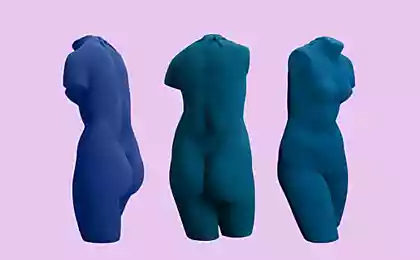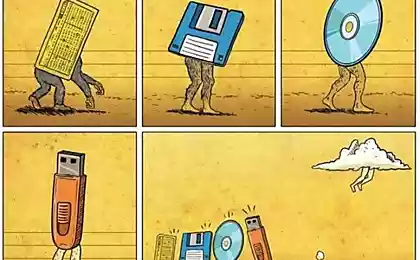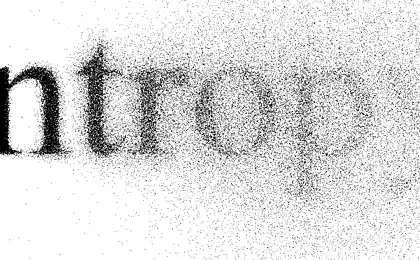1222
The history information storage (19 photos)
To understand how much the people in terms of information and advanced, thanks to this, evolved enough to recall the paper. Can you imagine civilization without papers and books? Clay tablets, papyrus rolls, wooden page ... Agree, not very comfortable to learn when a textbook and weighs a couple of tons per size of the living room? It would be a complete epic fail humanity. We would not be sitting with you on the Internet, and have saved their money for a third of his life in the book. And the beginning of the electronic information revolution, in the midst of which we are now, would never have taken place. It all began with a paper ...
Paper tape, Perforated. Home.
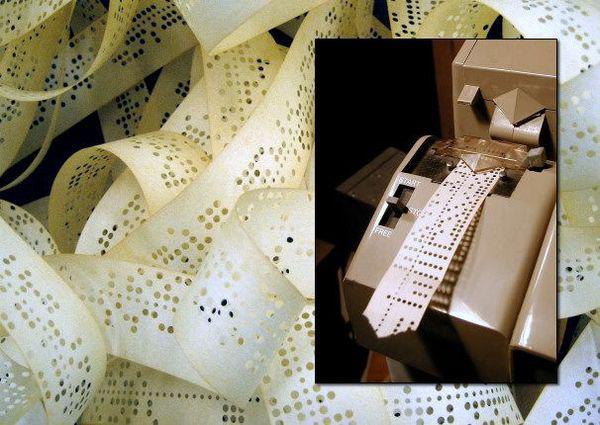
era of computers started much earlier than most hamsters. Of course, there was no microprocessor for Contra Strike video and webcam to talk of "Skype". In the usual sense of the computer today, it was not at all the computers and huge monsters tugodumayuschie operating a negligible amount of calculations using good old paper. Rather, the paper Lena wound onto spools. The information on the form thereof was kept in neat holes. Early machines type Colossus Mark I (1944 release) worked with the data manually. Perforated paper tape input as the paper in the printer in real time. However, over recent monster computers were able to read the program from the tape, for example, Manchester Mark I (1949 onwards), read the code from the tape and loaded it into a semblance of primitive electronic memory. Perforated tape was used to write and read data for over thirty years. This was the beginning of a new era - the information blossoming of mankind.
Punch cards
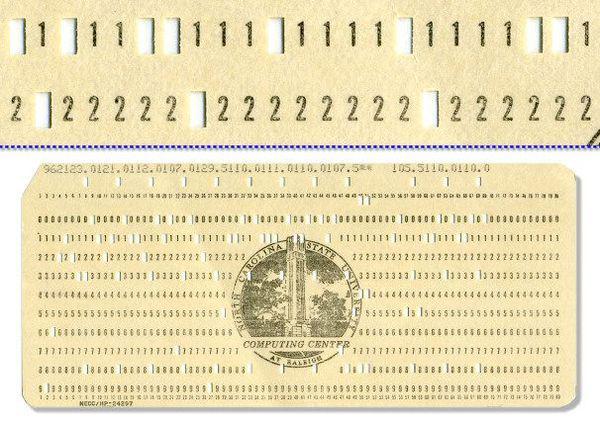
The history goes back deck of cards at the very beginning of the XIX century, when they were used to control looms. In 1890, Herman Hollerith punch card applied for the processing of census data in the United States. It was he who found the company (future IBM), which used these cards in their computers. In the 1950s, IBM already being used in your computer punch cards for storage and data entry, and soon began to use the media and other manufacturers. Then there were the common 80-column card, which for one character have a separate column. Some may be surprised, but in 2002, IBM is still ongoing developments in technology punched cards. However, in the XXI century the company was interested in the card the size of a postage stamp that can store up to 25 million pages of information.
Tape

Along with the release of the first American commercial computer UNIVAC I (1951) in the IT-industry, the era of the magnetic film. Pioneer, as usual, was again IBM, then "caught up" others. Tape wound open way to the coils and is a very thin strip of plastic coated with magnetically substance. Machines to write and read data using special magnetic heads built into the drive spool. Magnetic tape has been widely used in many models of the computers (especially mainframes and mini-computers) until 1980, until invented tape cartridges.
The first removable drives
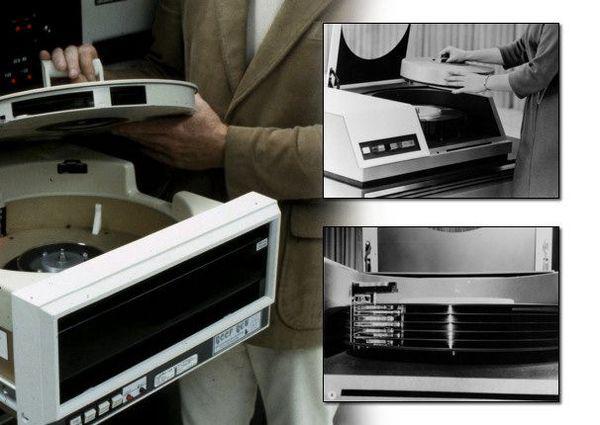
In 1963, IBM introduced the first hard drive with a removable drive - IBM 1311. It is a set of interchangeable disks. Each set consisted of six discs with a diameter of 14 inches, accommodating up to 2 MB of information. In the 1970s, many hard drives, for example, DEC RK05, supported by such disk sets, most often they were used for minicomputer vendors selling software.
Tape Cartridges
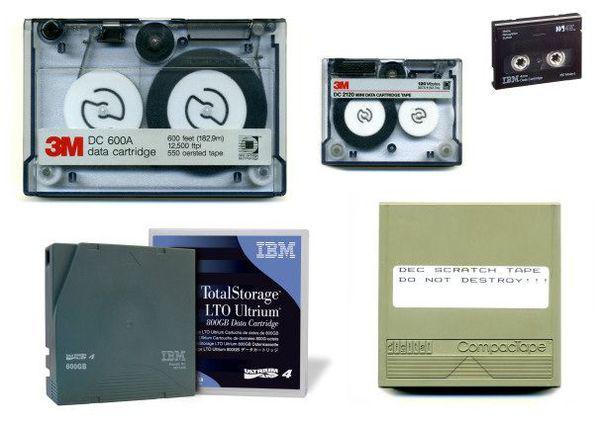
In the 1960s, computer hardware manufacturers have learned to put rolls of tape in miniature plastic cartridges. From its predecessors, reels, they are known for their life, portability and convenience. The greatest distribution they received in the 1970s and 1980s. As spools, cartridges were very flexible media: if you need to write down a lot of information into the cartridge just puts more tape. Today the type of tape cartridges 800 GB LTO Ultrium used to support large-scale servers, although in recent years their popularity has fallen because of the greater convenience of transferring data from the hard drive to the hard drive.
Printing on paper
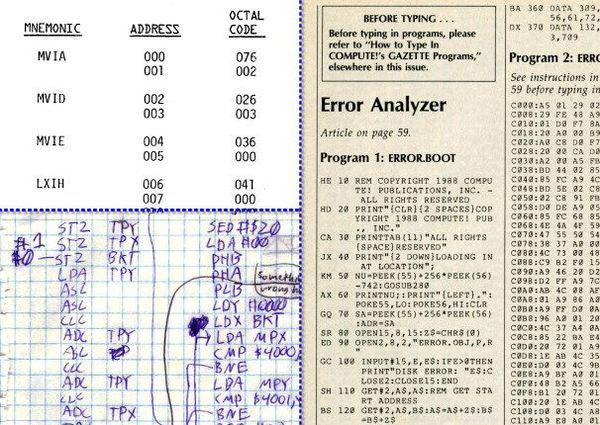
In the 1970s, due to the relatively low cost of personal computers are gaining popularity. However, existing methods of data storage for many could not afford. One of the first computer, MITS Altair delivers and even without recording media. The user is prompted to enter the program with special toggle switches on the front panel. Then, at the dawn of "desktops", users often had to literally inserted into the computer sheets with handwritten programs. Later, the program began to be distributed in printed form through the paper magazines.
Floppy
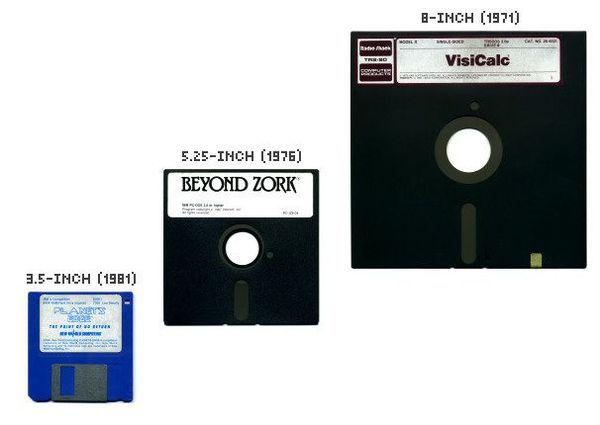
In 1971, the world had the first diskette IBM. It is a coating magnetic substance 8-inch floppy disk, placed in a plastic housing. People quickly realized that to load the data into the computer "floppy disks" faster, cheaper and more compact than a stack of punch cards. In 1976, one of the founders of the first floppy disk, Alan Shugart, offered her a new format - 5, 25 inches. This resolution lasted until the late 1980s until the 3.5-inch floppy disks Sony.
Compact Cassette
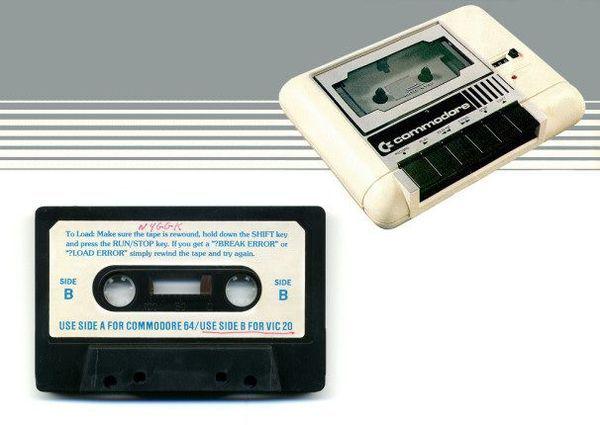
Compact Cassette was invented by Philips, which realized a cross between two small reels of magnetic tape in a plastic housing. It is in this format in the 1960s, made record. HP used these tapes in its desktop HP 9830 (1972), but at the beginning of such cassettes as carriers of digital information did not enjoy great popularity. Then searchers inexpensive storage media is still wrapped in the look of the cassette that with their light arms remained popular until the early 1980s. data on them, by the way, you can load a conventional audio player.
ROM-cartridge
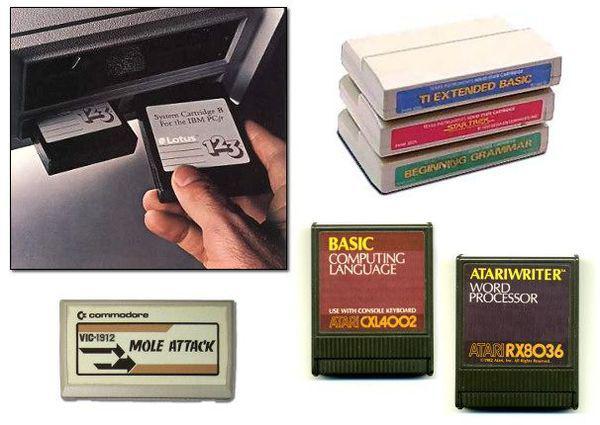
ROM-cartridge - is a charge consisting of a read only memory (ROM) and a connector placed in a hard shell. Application Cartridges - computer games and programs. For example, in 1976 the company released the Fairchild ROM-cartridge recording software for set top box Fairchild Channel F. Soon, under the use ROM- cartridges have been adapted and home computers such as Atari 800 (1979), or TI-99/4 (1979). ROM-cartridges are easy to use, but are relatively expensive, which is why, in fact, "died."
Great experiments diskettes
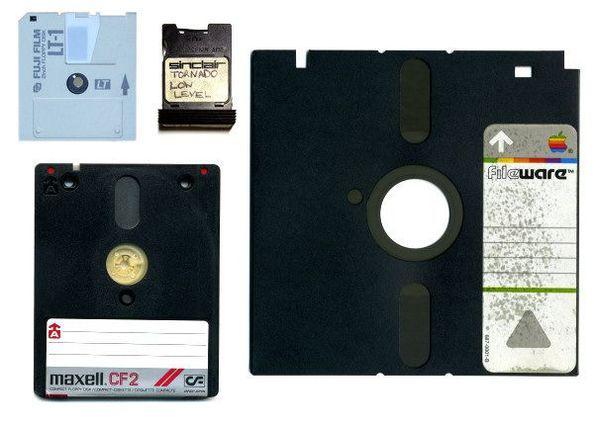
In the 1980s, many companies have tried to create an alternative to the floppy disk the size of 3, 5 inches. One such invention (above center) is hardly a stretch to even floppy: ZX Microdrive cartridge consisted of a huge skein tape cassette according to the principle vosmidorozhkovoy. Another experimenter, Apple, created a diskette FileWare (right), which comes with the first computer Apple Lisa - the worst device in the history of the company according to Network World, a well as a 3-inch Compact Disk (bottom left), and is now a rare 2-inch floppy LT 1 (top left), used exclusively in the laptop Zenith Minisport 1989 release. The rest of the experiments resulted in the creation of products that have become niche and could not repeat the success of its 5, 25 and 3-inch, 5-inch predecessors.
Optical drive
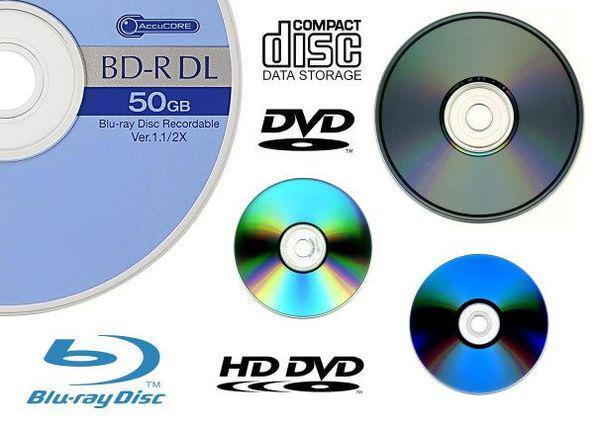
The CD, which was originally used as a medium of digital audio, owes its birth to the joint project by Sony and Philips, and first appeared on the market in 1982. Digital data are stored on this medium in the form of a plastic-pits on its mirror surface, and information is read using a laser head. It turned out that the digital CD is the best suited for storage of computer data, and soon the same Sony and Philips have finalized new. So in 1985 the world learned about the CD-ROMs. Over the next 25 years, an optical disk has undergone a lot of changes, its evolutionary chain includes DVD, HD-DVD and Blu-ray. A significant milestone was the appearance in 1988, CD-Recordable (CD-R), which allowed users to write data to disk. In the late 1990s, optical disks, finally fell, and finally pushed the diskette into the background.
Magneto-optical media
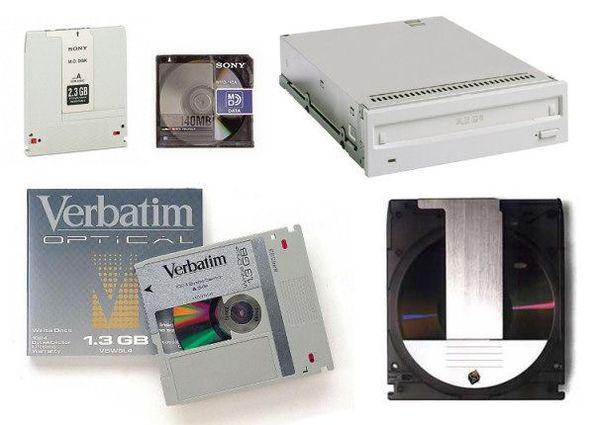
Like CDs, magneto-optical disks "reads" the laser. However, unlike conventional CD and CD-R media allows the majority of the magneto-optical repeatedly applied and erase data. This is achieved by the magnetic interaction of the laser and the recording data. The first magneto-optical disc included with the computer NeXT (1988, photo bottom right), and its capacity is 256 MB. The most famous of this type of vehicle - an audio MiniDisc Sony (top center, 1992). Was he, and "brother" to store digital data, which is called MD-DATA (top left). Magneto-optical drives are manufactured until now, but because of the low capacity and relatively high cost, they moved into the category of niche products.
And Iomega Zip Drive

Iomega announced itself in the market of media in the 1980s, releasing cartridges, magnetic disks Bernoulli Box, with a capacity of 10 to 20 MB. A more recent interpretation of the technology embodied in the so-called carrier Zip (1994), which seats up to 100 MB of data at a lower cost 3, 5-inch disc. Format liked the democratic price, and a good capacity, and Zip drives were on the crest of popularity until the end of the 1990s. However, already appeared while CD-R can be recorded up to 650 MB, and when the price has dropped to a few cents apiece, Zip-drives sales dropped dramatically. Iomega has made an attempt to save the developed technology and drives of 250 and 750 MB, but CD-R had already completely conquered the market. So Zip became history.
Floppiobraznye drives
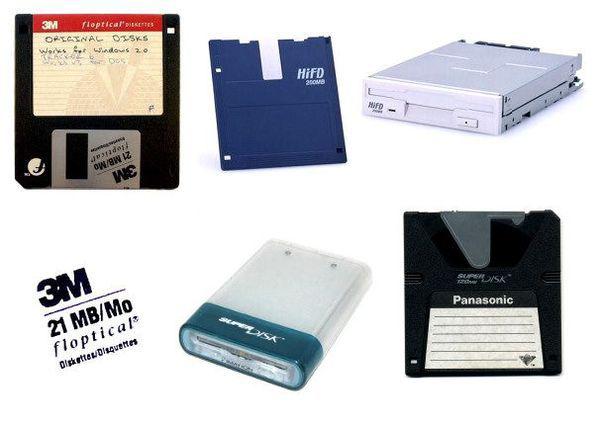
First released superdisketu Insight Peripherals Company in 1992. 3, 5-inch disk accommodates 21 MB of information. Unlike other carriers, the format is compatible with earlier conventional actuators 3, 5-inch floppy disk. The secret of the high efficiency of these drives wing combined optical and floppy disk, that is, data is written to a magnetic medium using a laser head, thus provides a more accurate and more recording tracks, respectively, more space. In the late 1990s, there were two new formats - Imation LS-120 SuperDisk (120 MB, bottom right) and Sony HiFD (150 MB, top right). New products have become serious competitors Iomega Zip drive, but in the end won the format of CD-R.
Mess in the world of portable media
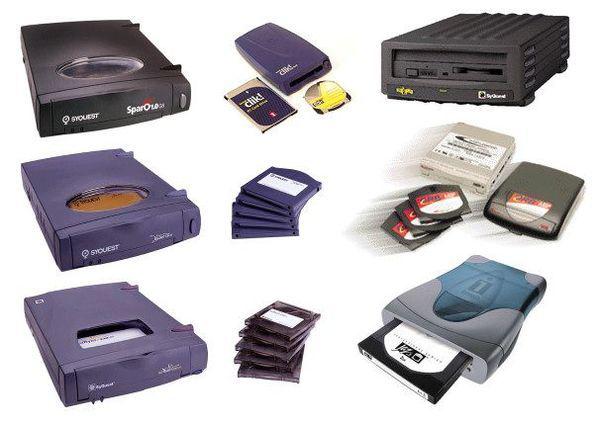
The resounding success of Zip Drive in the mid-1990s, has generated a lot of such devices, manufacturers are hoping to grab a piece of the market at the Zip. Among the major competitors may be noted Iomega SyQuest, who first shattered its own segment of the market and then destroyed its product line diversity excessive - SyJet, SparQ, EZFlyer and EZ135. Another serious, but "muddy" rival - Castlewood Orb, invented the Zip drive, like a capacity of 2, 2 GB. Finally, the company itself has tried to supplement the Iomega Zip drive other types of removable media - from large removable drives (1- and 2-gigabyte Jaz Drive) to a miniature Clik drive is 40 MB. But none of them reached the heights Zip.
Flash comes
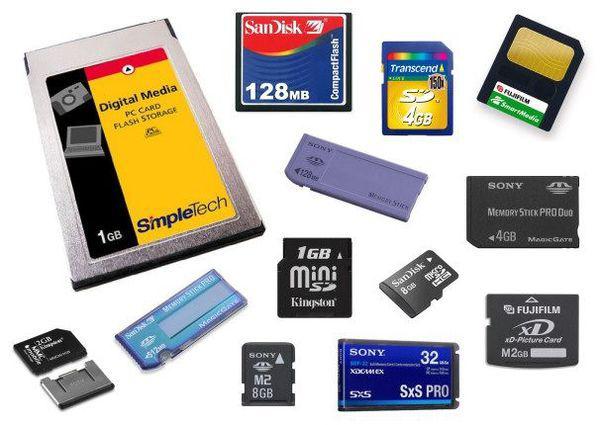
In the early 1980s, Toshiba invented flash memory NAND, but the technology became popular only a decade later, after the advent of digital cameras and PDA. At this time, it begins to be implemented in various forms - from large credit card (for use in earlier handhelds) up cards CompactFlash, SmartMedia, Secure Digital, Memory Stick and xD Picture Card. Flash memory cards are convenient, particularly in that they have no moving parts. In addition, they are economical, durable and relatively inexpensive at an ever-increasing amount of memory. The first CF card housed 2MB, now reaches its capacity of 128 GB.
What could be less ?!
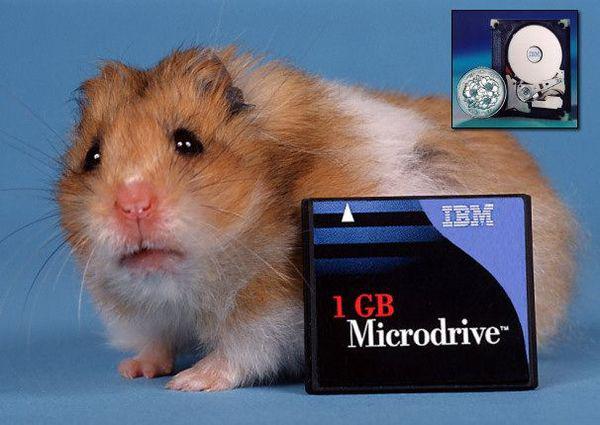
On promoslayde IBM / Hitachi hard drive shows a tiny Microdrive. He appeared in 2003 and for some time has won the hearts of computer users. Debuted in 2001, the iPod and other media players are equipped with similar devices on the basis of a rotating disk, but manufacturers quickly disappointed in this drive: it is too fragile power-consuming and small in volume. So this format is almost "buried».
The advent of USB. Viva, informacio!
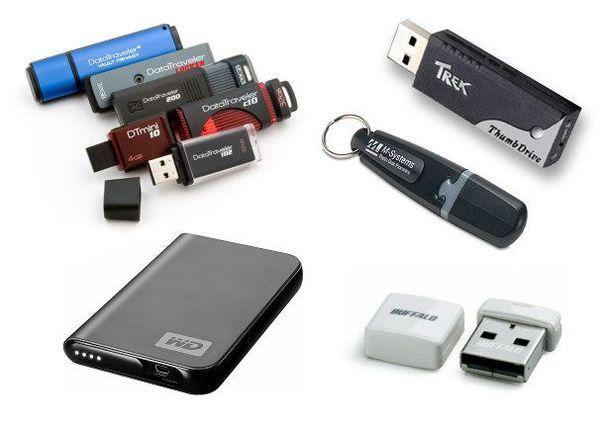
In 1998, the era of USB. The undeniable convenience of USB-devices has made them almost an integral part of life for all PC users. Over the years, they are reduced in physical size, but are becoming more capacious and cheaper. Especially popular was introduced in 2000, "stick", or USB thumb drives (from the English. Thumb - «thumb"), so named for its size - a human finger. Due to the high capacity and small size, USB-drives have become, perhaps, the best carrier of information, invented by mankind.
Coming virtual reality!
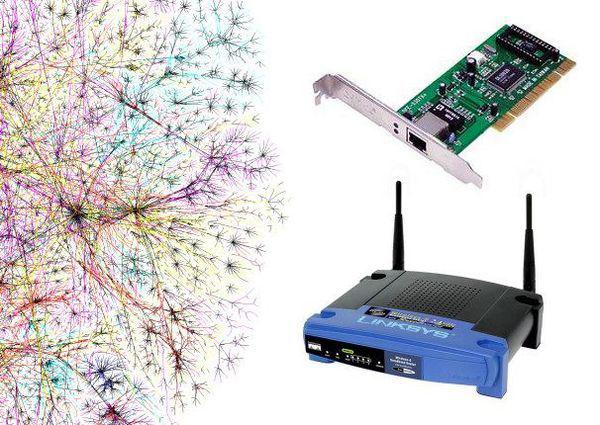
Paper tape, Perforated. Home.

era of computers started much earlier than most hamsters. Of course, there was no microprocessor for Contra Strike video and webcam to talk of "Skype". In the usual sense of the computer today, it was not at all the computers and huge monsters tugodumayuschie operating a negligible amount of calculations using good old paper. Rather, the paper Lena wound onto spools. The information on the form thereof was kept in neat holes. Early machines type Colossus Mark I (1944 release) worked with the data manually. Perforated paper tape input as the paper in the printer in real time. However, over recent monster computers were able to read the program from the tape, for example, Manchester Mark I (1949 onwards), read the code from the tape and loaded it into a semblance of primitive electronic memory. Perforated tape was used to write and read data for over thirty years. This was the beginning of a new era - the information blossoming of mankind.
Punch cards

The history goes back deck of cards at the very beginning of the XIX century, when they were used to control looms. In 1890, Herman Hollerith punch card applied for the processing of census data in the United States. It was he who found the company (future IBM), which used these cards in their computers. In the 1950s, IBM already being used in your computer punch cards for storage and data entry, and soon began to use the media and other manufacturers. Then there were the common 80-column card, which for one character have a separate column. Some may be surprised, but in 2002, IBM is still ongoing developments in technology punched cards. However, in the XXI century the company was interested in the card the size of a postage stamp that can store up to 25 million pages of information.
Tape

Along with the release of the first American commercial computer UNIVAC I (1951) in the IT-industry, the era of the magnetic film. Pioneer, as usual, was again IBM, then "caught up" others. Tape wound open way to the coils and is a very thin strip of plastic coated with magnetically substance. Machines to write and read data using special magnetic heads built into the drive spool. Magnetic tape has been widely used in many models of the computers (especially mainframes and mini-computers) until 1980, until invented tape cartridges.
The first removable drives

In 1963, IBM introduced the first hard drive with a removable drive - IBM 1311. It is a set of interchangeable disks. Each set consisted of six discs with a diameter of 14 inches, accommodating up to 2 MB of information. In the 1970s, many hard drives, for example, DEC RK05, supported by such disk sets, most often they were used for minicomputer vendors selling software.
Tape Cartridges

In the 1960s, computer hardware manufacturers have learned to put rolls of tape in miniature plastic cartridges. From its predecessors, reels, they are known for their life, portability and convenience. The greatest distribution they received in the 1970s and 1980s. As spools, cartridges were very flexible media: if you need to write down a lot of information into the cartridge just puts more tape. Today the type of tape cartridges 800 GB LTO Ultrium used to support large-scale servers, although in recent years their popularity has fallen because of the greater convenience of transferring data from the hard drive to the hard drive.
Printing on paper

In the 1970s, due to the relatively low cost of personal computers are gaining popularity. However, existing methods of data storage for many could not afford. One of the first computer, MITS Altair delivers and even without recording media. The user is prompted to enter the program with special toggle switches on the front panel. Then, at the dawn of "desktops", users often had to literally inserted into the computer sheets with handwritten programs. Later, the program began to be distributed in printed form through the paper magazines.
Floppy

In 1971, the world had the first diskette IBM. It is a coating magnetic substance 8-inch floppy disk, placed in a plastic housing. People quickly realized that to load the data into the computer "floppy disks" faster, cheaper and more compact than a stack of punch cards. In 1976, one of the founders of the first floppy disk, Alan Shugart, offered her a new format - 5, 25 inches. This resolution lasted until the late 1980s until the 3.5-inch floppy disks Sony.
Compact Cassette

Compact Cassette was invented by Philips, which realized a cross between two small reels of magnetic tape in a plastic housing. It is in this format in the 1960s, made record. HP used these tapes in its desktop HP 9830 (1972), but at the beginning of such cassettes as carriers of digital information did not enjoy great popularity. Then searchers inexpensive storage media is still wrapped in the look of the cassette that with their light arms remained popular until the early 1980s. data on them, by the way, you can load a conventional audio player.
ROM-cartridge

ROM-cartridge - is a charge consisting of a read only memory (ROM) and a connector placed in a hard shell. Application Cartridges - computer games and programs. For example, in 1976 the company released the Fairchild ROM-cartridge recording software for set top box Fairchild Channel F. Soon, under the use ROM- cartridges have been adapted and home computers such as Atari 800 (1979), or TI-99/4 (1979). ROM-cartridges are easy to use, but are relatively expensive, which is why, in fact, "died."
Great experiments diskettes

In the 1980s, many companies have tried to create an alternative to the floppy disk the size of 3, 5 inches. One such invention (above center) is hardly a stretch to even floppy: ZX Microdrive cartridge consisted of a huge skein tape cassette according to the principle vosmidorozhkovoy. Another experimenter, Apple, created a diskette FileWare (right), which comes with the first computer Apple Lisa - the worst device in the history of the company according to Network World, a well as a 3-inch Compact Disk (bottom left), and is now a rare 2-inch floppy LT 1 (top left), used exclusively in the laptop Zenith Minisport 1989 release. The rest of the experiments resulted in the creation of products that have become niche and could not repeat the success of its 5, 25 and 3-inch, 5-inch predecessors.
Optical drive

The CD, which was originally used as a medium of digital audio, owes its birth to the joint project by Sony and Philips, and first appeared on the market in 1982. Digital data are stored on this medium in the form of a plastic-pits on its mirror surface, and information is read using a laser head. It turned out that the digital CD is the best suited for storage of computer data, and soon the same Sony and Philips have finalized new. So in 1985 the world learned about the CD-ROMs. Over the next 25 years, an optical disk has undergone a lot of changes, its evolutionary chain includes DVD, HD-DVD and Blu-ray. A significant milestone was the appearance in 1988, CD-Recordable (CD-R), which allowed users to write data to disk. In the late 1990s, optical disks, finally fell, and finally pushed the diskette into the background.
Magneto-optical media

Like CDs, magneto-optical disks "reads" the laser. However, unlike conventional CD and CD-R media allows the majority of the magneto-optical repeatedly applied and erase data. This is achieved by the magnetic interaction of the laser and the recording data. The first magneto-optical disc included with the computer NeXT (1988, photo bottom right), and its capacity is 256 MB. The most famous of this type of vehicle - an audio MiniDisc Sony (top center, 1992). Was he, and "brother" to store digital data, which is called MD-DATA (top left). Magneto-optical drives are manufactured until now, but because of the low capacity and relatively high cost, they moved into the category of niche products.
And Iomega Zip Drive

Iomega announced itself in the market of media in the 1980s, releasing cartridges, magnetic disks Bernoulli Box, with a capacity of 10 to 20 MB. A more recent interpretation of the technology embodied in the so-called carrier Zip (1994), which seats up to 100 MB of data at a lower cost 3, 5-inch disc. Format liked the democratic price, and a good capacity, and Zip drives were on the crest of popularity until the end of the 1990s. However, already appeared while CD-R can be recorded up to 650 MB, and when the price has dropped to a few cents apiece, Zip-drives sales dropped dramatically. Iomega has made an attempt to save the developed technology and drives of 250 and 750 MB, but CD-R had already completely conquered the market. So Zip became history.
Floppiobraznye drives

First released superdisketu Insight Peripherals Company in 1992. 3, 5-inch disk accommodates 21 MB of information. Unlike other carriers, the format is compatible with earlier conventional actuators 3, 5-inch floppy disk. The secret of the high efficiency of these drives wing combined optical and floppy disk, that is, data is written to a magnetic medium using a laser head, thus provides a more accurate and more recording tracks, respectively, more space. In the late 1990s, there were two new formats - Imation LS-120 SuperDisk (120 MB, bottom right) and Sony HiFD (150 MB, top right). New products have become serious competitors Iomega Zip drive, but in the end won the format of CD-R.
Mess in the world of portable media

The resounding success of Zip Drive in the mid-1990s, has generated a lot of such devices, manufacturers are hoping to grab a piece of the market at the Zip. Among the major competitors may be noted Iomega SyQuest, who first shattered its own segment of the market and then destroyed its product line diversity excessive - SyJet, SparQ, EZFlyer and EZ135. Another serious, but "muddy" rival - Castlewood Orb, invented the Zip drive, like a capacity of 2, 2 GB. Finally, the company itself has tried to supplement the Iomega Zip drive other types of removable media - from large removable drives (1- and 2-gigabyte Jaz Drive) to a miniature Clik drive is 40 MB. But none of them reached the heights Zip.
Flash comes

In the early 1980s, Toshiba invented flash memory NAND, but the technology became popular only a decade later, after the advent of digital cameras and PDA. At this time, it begins to be implemented in various forms - from large credit card (for use in earlier handhelds) up cards CompactFlash, SmartMedia, Secure Digital, Memory Stick and xD Picture Card. Flash memory cards are convenient, particularly in that they have no moving parts. In addition, they are economical, durable and relatively inexpensive at an ever-increasing amount of memory. The first CF card housed 2MB, now reaches its capacity of 128 GB.
What could be less ?!

On promoslayde IBM / Hitachi hard drive shows a tiny Microdrive. He appeared in 2003 and for some time has won the hearts of computer users. Debuted in 2001, the iPod and other media players are equipped with similar devices on the basis of a rotating disk, but manufacturers quickly disappointed in this drive: it is too fragile power-consuming and small in volume. So this format is almost "buried».
The advent of USB. Viva, informacio!

In 1998, the era of USB. The undeniable convenience of USB-devices has made them almost an integral part of life for all PC users. Over the years, they are reduced in physical size, but are becoming more capacious and cheaper. Especially popular was introduced in 2000, "stick", or USB thumb drives (from the English. Thumb - «thumb"), so named for its size - a human finger. Due to the high capacity and small size, USB-drives have become, perhaps, the best carrier of information, invented by mankind.
Coming virtual reality!













